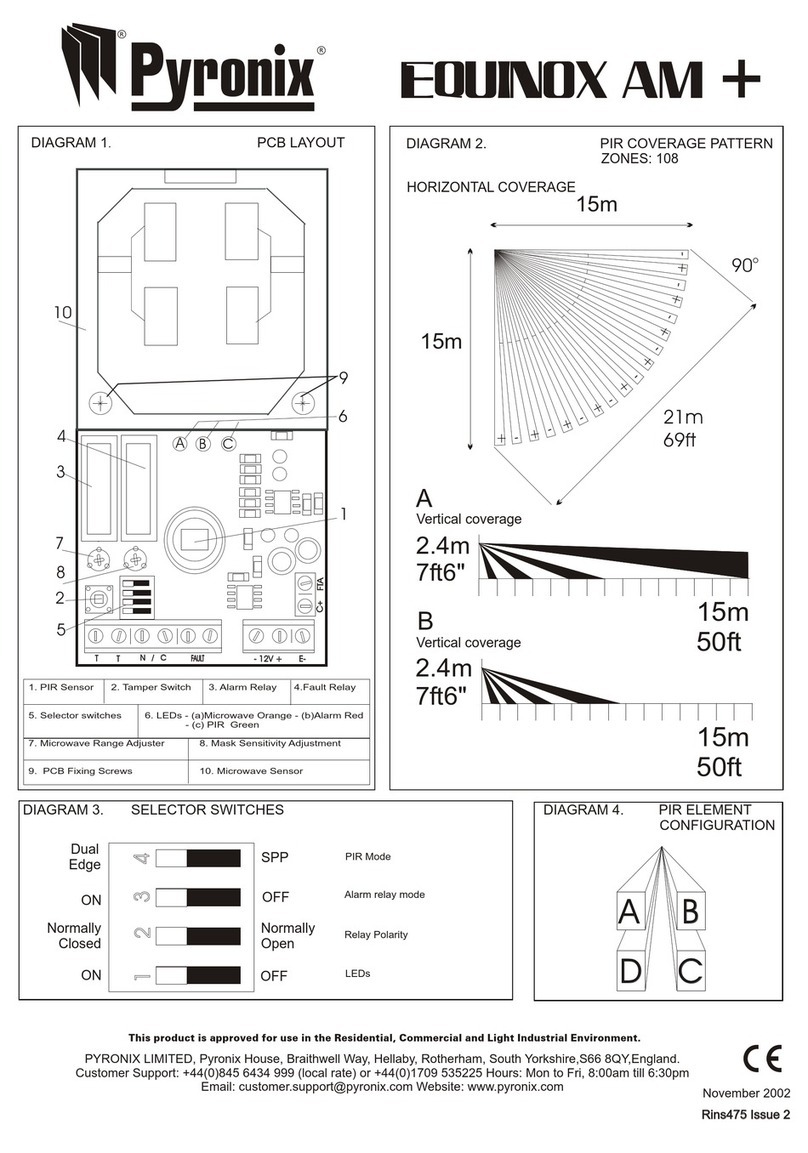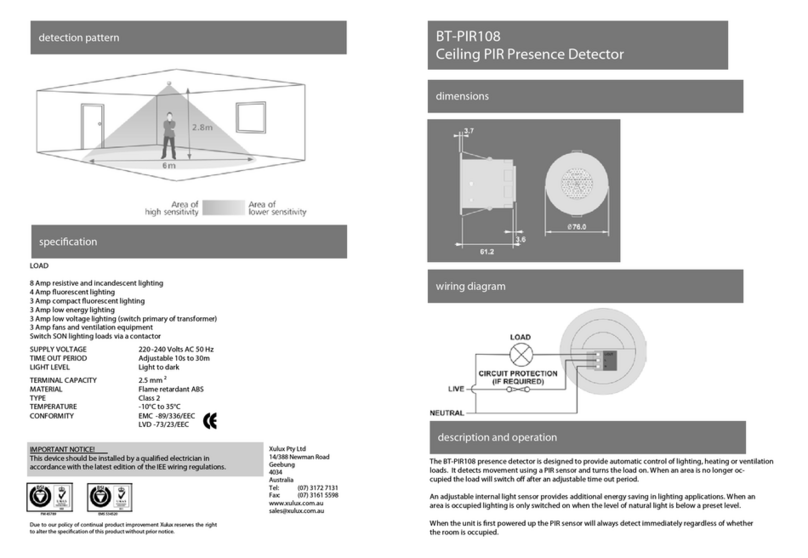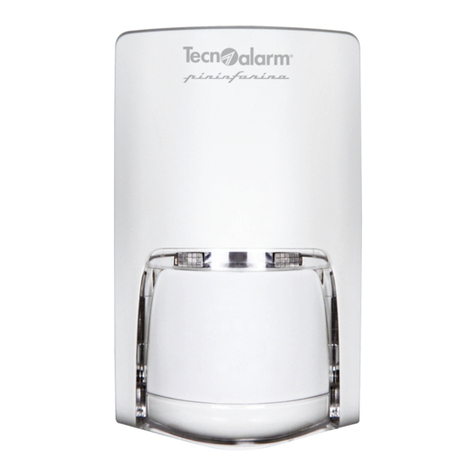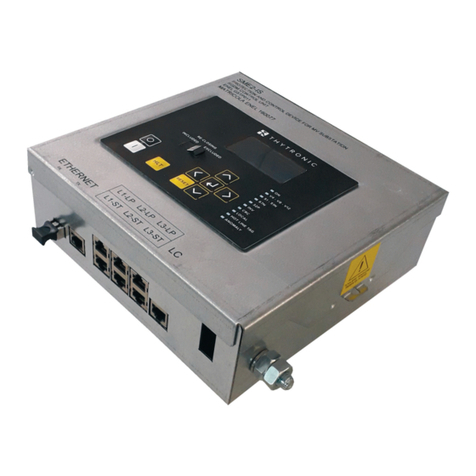Herth+Buss ELPARTS SelectH2 mini User manual

ELPARTS
DE
EN
FR
SelectH2
Lecksuchgerät, Klimaanlage
Leakage detector, air conditioning
Détecteur de fuite, climatisation
2006/40/EC
N
e
w
g
u
i
d
e
l
i
n
e
c
o
n
c
e
r
n
i
n
g
e
m
i
s
s
i
o
n
s
f
r
o
m
a
i
r
-
c
o
n
d
i
t
i
o
n
i
n
g
s
y
s
t
e
m
s

www.herthundbuss.com 2
DE
Bedienhinweis
Kapitel Seite
Inhalt
1. Einleitung 3
1.1 Anwendungen 3
1.2 Begriffe und Dimensionen 3
1.3 Symbole am SelectH23
2. Bedienung 4
2.1 Bedienelemente 4
2.2 Inbetriebnahme des Gerätes 4
2.3 Ablauf der Aufheizphase 5
2.3.1 Anzeigen der Leuchtdioden-Kette 5
2.4 Messbetrieb 5
2.5 Funktionsprüfung vor Beginn der Arbeit 6
2.6 Automatisches Umschalten auf andere Messbereiche 6
2.7 Überschreiten der UEG und Alarmmeldung 6
2.8 Tastenfunktionen im Messmodus 7
3. Kalibrierung 8
4.
Austausch des Sensorkopfes 8
5. Fehlermeldungen 8
5.1 Fehlercodes 9
6. Auaden der Akkus 9
7. Gerätetechnische Anforderungen nach DVWG G 465-4 und technische Daten 9
7.1 Allgemeine gerätetechnische Anforderung nach DVGW G 465-4 9
8. Lecksuche an der Klimaanlage 9
8.1 Messbereich [ppm] 10
8.2 Erkennen der Leckstelle 10
8.3
„Umfühlen“ der Leitung mit dem SelectH
2
10
9. Kurzanleitung 11
10. Serviceadresse 11

3
DE
1. Einleitung
1.1 Anwendungen
Das SelectH2Gasspürgerät ist ein selektives
und anzeigeempndliches Gasspürgerät für
Wasserstoff. Der Anzeigebereich des Displays
erstreckt sich von 0ppm bis zur unteren Ex-
plosionsgrenze (UEG) des Gases. Der Bereich
ist im Mikroprozessor gespeichert und kann
über selektive Sensoren abgerufen werden.
Das SelectH2ist mit einer Ansaugpumpe, ei-
nem GGS 1000 und GGS 6000 ausgerüstet.
1.2 Begriffe und Dimensionen
ppm
Steht für parts per million = Anzahl der Teil-
chen pro einer Millionen anderer Teilchen
– ein in der Gasspürtechnik gebräuchlicher
Wert für kleinste Mengen. 1ppm ist die Men-
ge von 1cm3 Gas in 1m3 Luft. 1ppm = 0,0001
Vol%, also ist 0,1% Gas = 1000 ppm.
Untere Explosionsgrenze UEG
Brennbare Gase erreichen bei bestimmten,
aber nach Gasart unterschiedlichen Werten
des Gemisches mit Luft (Luftsauerstoff),
einen Punkt, an dem bei Einwirken von
Zündquellen eine explosionsartige Zün-
dung erfolgt. Diese so genannte untere Ex-
plosionsgrenze (manchmal auch als untere
Zündgrenze “UZG” bezeichnet) beträgt bei
Wasserstoff 4,0 Vol%. Es genügen also re-
lativ geringe Mengen, um ein zündfähiges
Gemisch zu erreichen. Die nachstehende Ab-
bildung zeigt das am Beispiel eines Raumes.
Bei allmählicher Auffüllung mit Gas wird der
Wert von 4,0% schnell erreicht. Der Bereich
von 0% Gas bis zur UEG wird in % der UEG
unterteilt. 4,0% Wasserstoff in Luft entspre-
chen 100% der UEG.
Das SelectH2meldet durch akustische Signale
die Annäherung an diesen UEG-Wert.
UEG: untere Explosionsgrenze
OEG: obere Explosionsgrenze
1.3 Symbole am SelectH2
Weitere Informationen bezüg-
lich der ordnungsgemäßen Ent-
sorgung dieses Produkts in ei-
nem bestimmten Land gemäß
den Bestimmungen der WEEE-Richtlinie
können vom Lieferanten des Geräts einge-
holt werden.
Technische Daten:
Bedienhinweis

www.herthundbuss.com 4
DE
Bedienhinweis
Sicherheitshinweise
Auch wenn bei einer bestimmten Position des
Gerätes im Raum – z.B. in üblicher Arbeitshö-
he – eine Konzentration gemessen wird, die
unterhalb der UEG liegt, so kann doch an an-
deren Stellen im Raum oder im Gebäude eine
höhere Konzentrationsansammlung vorhan-
den sein die im Ex-Bereich liegt.
Gasprüfverfahren
Das Gasprüfverfahren mit Formiergas 5/95
(5% Wasserstoff in Stickstoff) wurde für die
Ortung von kleinsten, mit akustischen Me-
thoden nicht ortungsfähigen Leckstellen
entwickelt. Bei einer Selektivität der Anzeige
auf Wasserstoffgas gibt es keine Störungen
durch andere Gase wie z.B. Methangas oder
Faulgas. Um eine ausführliche Beschreibung
der Methode mit Praxisbeispielen zu erhal-
ten, fragen Sie bitte bei Herth+Buss nach.
2. Bedienung
2.1 Bedienelemente
Ansaugrohr
LED für verschiedene
Meßbereiche
Display
Funktionstasten
Ladebuchse
Ladekontrolle
Abgas-Austritt
2.2 Inbetriebnahme des Gerätes
Achten Sie vor Inbetriebnahme auf eine voll-
ständige Auadung der eingebauten Akkus.
Einzelheiten sind im Kapitel 5 beschrieben.
On/Off Taste für ca. 2 s ge-
drückt halten. Das Gerät
schaltet sich ein. Auf dem
Display werden alle zur
Verfügung stehenden Se-
gmente kurz angezeigt.
Anschließend erscheint auf dem Display die
Gasart-Anzeige (H2) und HEAt, welches den
ca. 50 sekündigen Aufheizzyklus ankündigt.

5
DE
Bedienhinweis
2.3 Ablauf der Aufheizphase
Der Ablauf der Initialisierung ist bei jedem
Start identisch. Mit Fortgang wächst die
analoge Balkenanzeige nach rechts über
die Skala. Nach dem Erreichen des maxima-
len Wertes erfolgt die Umschaltung in den
Messmodus.
2.3.1 Anzeigen der Leuchtdioden-Kette
In der Kette der Leuchtdioden – angeordnet
zwischen Sensorkopf und den Schalttasten –
zeigt die erste Diode den „Betrieb“ an.
Bei Aufkommen von Gasspuren erfolgt eine
Anzeige im Display und ein Zuschalten wei-
terer Dioden in Abhängigkeit von der Kon-
zentration. Das (abschaltbare) akustische
Signal macht die Zunahme auch hörbar.
Mit dem Einschalten leuchten zur Funkti-
onskontrolle zunächst alle Dioden auf
Nach Abschluss der Aufheizphase von
ca. 45 Sekunden leuchtet nur noch die
grüne Diode und zeigt die Betriebsbereit-
schaft an. Im Display wird 0ppm sichtbar
Mit Aufkommen und Zunahme einer
Gaskonzentration erfolgt die Meldung
in Schwellenstufen von über 100 und
1000ppm bis zu 1 Vol% (10000ppm)
Parallel dazu wird die Zunahme der Gas-
konzentration durch die Veränderung des
akustischen Signals gemeldet
2.4 Messbetrieb
Der zeitliche Ablauf der Aufheizphase wird
mit dem Analogbalken, der sich von links
nach rechts aufbaut, verfolgt. Nach der Auf-
heizphase ist der Sensor-Nullpunkt ermittelt
und gilt für den weiteren Messbetrieb als
Frischluft-Bezugswert.
Alle Schwellen-LEDs sind nur zu Anfang
aktiv. Der erste grob geschätzte Messwert
liegt nach ca. 12 Sekunden vor und kann nur
durch die Schwellen-LEDs zur Anzeige ge-
bracht werden.
Mit Abschluss der Aufheizphase wird sofort
in den Messmodus geschaltet. Hier wird auf
dem Display eine geringe Gaskonzentration
unter 999 in ppm und über 999ppm in Vol%,
beginnend mit 0,1 Vol% angezeigt.
In zielgasfreier Atmosphäre soll das Gerät
0ppm anzeigen.

www.herthundbuss.com 6
DE
Bedienhinweis
2.5 Funktionsprüfung vor
Beginn der Arbeit
Lag das Gerät für längere Zeit in hochbelas-
teter, schmutziger Luft, so kann auf Grund
von Partikelablagerungen am Sensor eine
Untergrundkonzentration angezeigt werden.
Erst nach längerem Betrieb wird der Sensor
allmählich sauber und erreicht wieder sei-
nen ursprünglichen Nullpunktwert.
Die Diffusionsäche des Sensorkopfes muss
sauber gehalten werden und hat frei zu blei-
ben von Ölen oder Fetten. Ein Ansprühen mit
verdampfenden Flüssigkeiten oder Gasen
verfälscht die späteren Messergebnisse.
2.6 Automatisches Umschalten auf
andere Messbereiche
Die Anzeige von Gaskonzentrationen erfolgt
bis 999ppm in diesem Wert. Bei Überschrei-
ten von 999ppm wird ab 1000ppm = 0,1 Vol%
die Anzeige in Vol% sichtbar.
Die Konzentrationen werden nun in Schritten
von 0,1% angezeigt. Der Analogbalken erreicht
bei 1,0 Vol% die gesamte Anzeigenbreite.
2.7 Überschreiten der UEG
und Alarmmeldung
Bei Überschreitung der UEG des Gases wird
UEG angezeigt. Konform zur numerisch
ausgegebenen Konzentration schalten die
„Schwellen-LEDs“ nach 10, 100, 1000ppm
und 1 Vol%. Der Analogbalken hat im Mess-
modus die Funktion einer zusätzlichen Kon-
zentrationsanzeige und wird bei Erreichen
der 1 Vol% voll dargestellt. Die Balkenanzei-
ge hat einen linearen Auösungsbereich.
Ein unterbrochenes akustisches Signal ist
hörbar, welches bei höheren Konzentra-
tionen in der Schnelligkeit zunimmt und
nach Überschreiten der UEG-Schwelle zum
Dauerton wird. Wird beim Messen die UEG
erreicht, dann bleibt UEG auf dem Display
angezeigt, auch wenn die Gaskonzentration
wieder fällt. Ein Rücksetzen dieses Zustan-
des in den normalen Messmodus kann nur
durch Abschalten und erneutes Wiederein-
schalten des Gerätes oder durch Betätigen
der rechtenTaste (2x Signalton) erfolgen.
WARNUNG
Wird in einem Raum oder Behälter eine
bestimmte Konzentration unterhalb der
UEG angezeigt, dann kann an ande-
rer Stelle durch Auftrieb des leichten
Gases oder „Abießen“ des schweren
Gases – trotzdem ein explosives Gas-
Luft-Gemisch vorhanden sein

Bedienhinweis 95980002
7
DE
2.8 Tastenfunktionen im Messmodus
1. Funktionsebene:
Taste drücken bis kurzer Signalton
zu hören ist.Taste loslassen
2. Funktionsebene:
Taste länger gedrückt halten bis 2 kurze
Signaltöne zu hören sind.Taste loslassen.
ObereTaste:
Hintergrundbeleuchtung für LCD und Tasten
ein- bzw. ausschalten. Grundsätzlich schal-
tet sich die Hintergrundbeleuchtung auto-
matisch mit einer Nachlaufzeit von ca. 15
Sekunden ein: nach Einschalten des Gerätes
und Ablauf der Aufheizphase; nach jeder Be-
tätigung einer Funktionstaste.
Permanent ein- bzw. ausschalten lässt sich
die Hintergrundbeleuchtung mit der oberen
Taste. Für das Ausleuchten des LCD sind
zwei LEDs vorgesehen. Für die Tastatur ist
eine LED vorgesehen.
RechteTaste:
Die rechte Taste ist mit Funktionen
doppelt belegt:
1. Funktionsebene:
im Messmodus: Signaltongeber ein-
bzw. ausschalten im Kalibriermodus:
Bestätigungstaste
2. Funktionsebene:
Fangmodus bei Überschreiten der
UEG zurücksetzen
Mit der rechten Taste kann der Signalton-
geber ein- bzw. ausgeschaltet werden. Der
aktuelle Zustand (Signaltongeber ein- bzw.
ausgeschaltet) ist im Display durch das Son-
dersegment Lautsprecher zu erkennen. In der
2. Funktionsebene wird der Fangmodus bei
Überschreiten der UEG zurückgesetzt. Auf
dem Display erscheint für 2 Sekunden CLr. Im
Kalibriermodus dient die rechteTaste zum Be-
stätigen der einzelnen Kalibrierschritte.

Bedienhinweis 95980002
www.herthundbuss.com 8
DE Linke Taste:
1. Funktionsebene:
Einblendung des momentan
eingestellten Gastyps H2
2. Funktionsebene:
Konzentrationsausgabe auf Untergrundkon-
zentration normieren (Umschalten zwischen
absolutem und relativem Messen)
In der 2. Funktionsebene wird die Konzent-
rationsausgabe auf die momentane Konzen-
tration normiert. Es können aber maximal
250ppm unterdrückt werden. Im Display er-
scheint das Sondersegment SET.
Untere Taste:
Ein- und Ausschalten des Gerätes.
3. Kalibrierung
Es wird empfohlen, das Gerät einmal pro
Jahr zur Überprüfung und Neukalibrierung
an den Hersteller oder eingewiesenes Fach-
personal zu senden.
4.
Austausch des Sensorkopfes
Jedem Gerät ist zur Kalibrierung vor Auslie-
ferung ein bestimmter Sensorkopf zugeord-
net worden. Bei Austausch des Sensorkop-
fes, z.B. bei einer Nachrüstung mit einem
Ersatzsensor, ist eine neue Kalibrierung er-
forderlich.
5. Fehlermeldungen
Bei Akku-Unterspannung erscheint auf dem
Display das Sonderzeichen (Akku) und die
LED „Betrieb“ blinkt. In diesem Betriebszu-
stand kann mit dem Gerät noch mindestens
15 Minuten gearbeitet werden.
Das Gerät überprüft sowohl im Messmodus
als auch im Kalibriermodus die Sensorwerte
auf Plausibilität. Darüber hinaus wird nach
jedem Einschalten des Gerätes der Parame-
terspeicher auf Datengültigkeit getestet. Bei
Fehlererkennung wird der entsprechende
Fehlercode auf dem Display ausgegeben.

Bedienhinweis 95980002
9
DE
5.1 Fehlercodes
ERR P Störung Gasuss
E 32 Kalibrierdatenfehler
E 64 Sensorbruch
E 128 Parameterspeicher fehlerhaft
E 192 Parameterspeicher fehlerhaft und
Sensorbruch
6. Auaden der Akkus
Während des Ladens muss das Gerät aus-
geschaltet sein. Mit dem mitgelieferten Ste-
ckernetzteil (max. Ladestrom 150 mA) wird
der Akku innerhalb von 12 bis 14 Stunden
aufgeladen. Die rote LED an der Gehäuse-
rückseite signalisiert den Ladevorgang und
leuchtet permanent während des Auadens.
Das Laden sollte imTemperaturbereich von 0
... 45°C erfolgen. Unter normalen Bedingun-
gen können mehr als 500 Lade- bzw. Entla-
dezyklen erwartet werden. Langzeitlagerung
oder zu langes Auaden der Akkus führen zu
einer verminderten Zellenkapazität. Dieser
Kapazitätsverlust kann durch eineVollladung
oder durch 1 bis 3 Lade- und Entladezyklen
kompensiert werden.
7. Gerätetechnische Anforderun-
gen nach DVWG G 465-4 und
technische Daten
7.1 Allgemeine gerätetechnische
Anforderung nach DVGW G 465-4
Dieser DVGW-Hinweis betrifft mobile Geräte
zur Feststellung von Leckstellen an Anlagen
der öffentlichen Gasversorgung sowie an
kundeneigenen Anlagen (Hausinstallationen).
Unter dem Begriff „Gasspürgeräte“ sind da-
bei Geräte für den Nachweis von Gaskonzen-
trationen mit einer Nachweisempndlichkeit
von < 100ppm Brenngas zu verstehen, also
Geräte, die vorzugsweise für den Gasnach-
weis bei der Lecksuche verwendet werden.
Die geforderten Eigenschaften der Geräte
sollen – soweit zutreffend – in der Betriebsan-
leitung der Hersteller genannt werden.
8. Lecksuche an der Klimaanlage
Bei der Lecksuche an der Klimaanlage wer-
den die mitgelieferten Teile (Servicekupp-
lung, Schlauch, Druckminderer, Gasasche)
mit der Anlage verbunden.
Druckminderer handfest auf die
Gasasche schrauben;
Servicekupplung auf den Füllanschluss
stecken;
Ventil der Gasasche langsam öffnen
und die Klimaanlage mit Formiergas 95/5
füllen. Der Fülldruck beträgt ca. 5 bar.
Motor kurz durchstarten und mit dem
SelectH2die Leckortung beginnen; Nach
der erfolgreichen Lecksuche und der Be-
hebung der Undichtigkeit im System wird
empfohlen, die Anlage vor dem Füllen mit
Öl und Kältemittel erneut zu evakuieren.
Beim Befüllen ist auf die vorgeschriebene
Füllmenge vom Hersteller zu achten! Das
Prüfgas (Formiergas 95/5) ist für Mensch
und Material vollkommen unschädlich.
Achtung: Beim Umgang mit der Gas-
asche, bitte Sicherheitsbestimmungen
beachten – siehe Aufschrift Gasasche.

Bedienhinweis 95980002
www.herthundbuss.com 10
DE 8.1 Messbereich [ppm]
Die hohe Empndlichkeit des SelectH2Gas-
spürgerätes ermöglicht ein Erkennen von
Gasspuren im ppm-Bereich. 1ppm ist bei-
spielsweise die Menge von 1cm3 Gas in
einem m3 Luft. Beim Herth+Buss SelectH2
Gasspürgerät wird bis zu 999ppm in dieser
Dimension gemessen. Beim Übergang zu
1000ppm wechselt die Anzeige in den Bereich
Vol% und schaltet auf 0,1 Vol% (siehe die Ver-
gleichswerte in der nachstehendenTabelle).
Die Dimension [ppm]: 1ppm = 1 part per
million = 1Teil pro MillionenTeile
100 % = 1.000.000 ppm
10 % = 100.000 ppm
1 % = 10.000 ppm
0,1% = 1.000 ppm
0,01 % = 100ppm
0,001 % = 10 ppm
0,0001 % = 1 ppm
8.2 Erkennen der Leckstelle
Die ausströmende Gasmenge bestimmt –
wie in 8.3 beschrieben – die Ausbreitungs-
weite. Weil aber der Ausbreitungsbereich
nicht bekannt ist, muss jede Verbindungs-
stelle der zugänglichen Leitungsteile abge-
spürt werden. Kommt nun der Sensorkopf
des Gerätes in die „Gaswolke“, dann diffun-
diert das leichte Gas in den Sensorkopf und
wirkt auf den gasempndlichen Halbleiter.
Für den Messvorgang werden je nach Stär-
ke der Gaskonzentration etwa 2-3 sec ge-
braucht. Das bedeutet für die Prüfpraxis:
Ein nur kurzes Heranführen an dieVerschrau-
bung oder an den Fitting mit Hanfgewinde
reicht für ein Erkennen kleiner Gasausströ-
mungen nicht aus.
8.3
„Umfühlen“ der Leitung
mit dem SelectH
2
In der Praxis hat sich ein langsames „Um-
fühlen“ der Verbindungsstellen bewährt. So
wird am ehesten die kleine austretende Gas-
blase erkannt.

Bedienhinweis 95980002
11
DE
9. Kurzanleitung
Wichtiger Hinweis: Für alle Details, z.B. Licht-
oder Signal-AN/AUS, Kalibrierungen oder
Auaden des Gerätes, ist unbedingt die aus-
führliche Bedienungsanleitung zu beachten.
Einschalten durch Betätigen dieser Taste
(nur in gasfreier Atmosphäre) Nach dem
Einschalten blinkt die LCD-Anzeige während
der ca. 50 Sekunden dauernden Aufheizpha-
se im Wechsel zwischen H2 und HEAt. Der
Analogbalken am unteren Rand der Anzeige
baut sich von links nach rechts auf.
Nach Abschluss der Aufheizphase zeigt die
Anzeige 0 ppm. Es kann nun mit den Mes-
sungen begonnen werden.
Bei einer gemessenen Konzentration steigt
die Anzeige zunächst bis 999 ppm, schaltet
mit 0,1% in den Messbereich Vol%. Bei über
4,0 Vol% erfolgt die Meldung UEG. Diese
wird durch einen Dauerton bestätigt. Anzei-
ge und Signal sind auch durch einen Wech-
sel in „sauberer Luft“ nicht zu löschen. In
gasfreier Atmosphäre soll ein Ausschalten
des Gerätes erfolgen.
WARNUNG
Bei einer Gasmeldung mit UEG und
Dauerton kann es sich um ein explosi-
onsfähiges Gas-Luft-Gemisch handeln.
Ausschalten: EIN/AUS-Taste für 2 Sekunden
gedrückt halten.
10. Serviceadresse
Bei Reklamationen, Kalibrierung und Repa-
raturen außerhalb der Gewährleistung, schi-
cken Sie die Geräte bitte an folgende Servi-
ceadresse:
Herth+Buss Fahrzeugteile GmbH & Co. KG
Dieselstraße 2-4
63150 Heusenstamm
Tel: +49 (0) 6104 / 608-0
E-Mail: [email protected]
Achtung! Kaufnachweis und
Zubehörteile nicht vergessen.

Operating Instruction 95980002
www.herthundbuss.com 12
EN Chapter Page
Content
1. Introduction 13
1.1 Applications 13
1.2 Terms and dimensions 13
1.3 SelectH2symbols 13
2. Operation 14
2.1 Operating controls 14
2.2 Putting the device into operation 14
2.3 Heat-up phase sequence 15
2.3.1 Light-emitting diode chain displays 15
2.4 Measuring operation 15
2.5 Functional check before starting work 16
2.6 Automated switching to other measuring ranges 16
2.7 Exceeding the LEL and alarm signal 16
2.8 Button functions in measuring mode 17
3. Calibration 18
4. Replacing the sensor head 18
5. Error messages 18
5.1 Error codes 19
6. Charging the battery 19
7. Device-related requirements in accordance with DVWG G 465-4 and technical data 19
7.1 General device-related requirement in accordance with DVGW G 465-4 19
8. Leak detection on the A/C system 19
8.1 Measuring range [ppm] 20
8.2 Detecting leaks 20
8.3 “Feeling around” the pipe using the SelectH220
9. Brief instructions 21
10. Service address 21

Operating Instruction 95980002
13
EN
1. Introduction
1.1 Applications
The SelectH2gas detector is a selective and
sensitive hydrogen gas detector. Indication
on the display ranges from 0 ppm up to the
lower explosion limit (LEL) of the gas. The
range is stored in the microprocessor and
can be requested through selective sen-
sors.The SelectH2is equipped with a suction
pump, a GGS 1000 and GGS 6000.
1.2 Terms and dimensions
ppm
Stands for parts per million = number of
parts per million other parts, a customary
value for smallest quantities in gas detec-
tion. 1 ppm is the quantity of 1cm3 gas in
1m3 of air. 1ppm = 0.0001 vol%, therefore
0.1% gas = 1000 ppm.
Lower explosion limit LEL
At certain values in a mixture with air, differ-
ent depending on the type of gas, combusti-
ble gases reach a point at which the inuence
of an ignition source results in an explosive
ignition.This is referred to as the lower explo-
sion limit (or sometimes lower ammable
limit “LFL”) and is 4.0 vol% for hydrogen.This
means that relatively small quantities are
enough to create a ammable mixture. The
following gure shows this using a room as
an example. Gradual lling with gas results
in the value of 4.0% being reached quickly.
The range from 0% gas to the LEL is divided
into % of the LEL. 4.0% hydrogen in air cor-
responds to 100% of the LEL.
The SelectH2uses acoustic signals to indi-
cate that this LEL value is being approached.
LEL: Lower explosion limit
UEL: Upper explosion limit
1.3 SelectH2symbols
Contact the equipment supplier
for details on how to properly
dispose of this product within
specic country, per WEEE re-
quirements.
Technical data:

Operating Instruction 95980002
www.herthundbuss.com 14
EN
Safety notes
Even if a concentration under the LEL is
measured in a certain position of the device
in the room, e.g. at normal working height,
it is possible that there may be a higher con-
centration in the explosive range in other
parts of the room or the building.
Gas testing method
The gas testing method with forming gas 5/95
(5% hydrogen in nitrogen) was developed to
locate the smallest leaks, those that cannot
be located using acoustic methods.The selec-
tion of hydrogen gas means there is no inter-
ference from other gases such as methane or
sludge gas. Please contact Herth+Buss for a
detailed description of the method, including
practical examples if required.
2. Operation
2.1 Operating controls
Intake pipe
LED for different
measuring ranges
Display
Function buttons
Charging socket
Charge control
Exhaust gas outlet
2.2 Putting the device into operation
Before putting the device into operation,
make sure the built-in rechargeable bat-
tery is fully charged. Details can be found in
Chapter 5.
Press and hold the On/Off
button for approx. 2 sec-
onds. The device switches
on. All the available seg-
ments are shown briey
on the display.
Then the gas type display (H2) and the word
HEAt appear on the display, announcing the
start of the 50-second heat-up cycle.

Operating Instruction 95980002
15
EN
2.3 Heat-up phase sequence
The initialisation sequence is identical for
every start. As it progresses, the analogue
bar display expands towards the right
across the scale. Once the maximum value
has been reached, the device switches to
measuring mode.
2.3.1 Light-emitting diode chain displays
In the chain of light-emitting diodes - lo-
cated between the sensor head and the
switching buttons - the rst diode shows
the “operation”.
If traces of gas are detected, this is shown
in the display and additional diodes are ac-
tivated depending on the concentration.The
acoustic signal (which can be deactivated)
means that the increase can also be heard.
When switching on, all the diodes light
up initially as a function check.
After the heat-up phase of approx.
45 seconds is completed, only the green
diode remains lit, indicating operational
readiness. 0 ppm becomes visible in the
display
When a gas concentration arises and
increases, this is indicated in threshold
stages, from over 100 and 1000 ppm up
to 1 vol% (10000 ppm)
At the same time, the increase in gas
concentration is indicated by the change
in the acoustic signal.
2.4 Measuring operation
The time sequence of the heat-up phase is
tracked using the analogue bar that builds
up from the left to the right. After the heat-up
phase, the sensor zero point is determined
and applies as the fresh air reference value
for continued measuring operation.
All threshold LEDs are only active at the
start. The rst roughly estimated measure-
ment value is available after approx. 12 sec-
onds and can only be displayed using the
threshold LEDs.
Once the heat-up phase is completed, the
device immediately switches to measuring
mode. Here, a low gas concentration under
999 is displayed in ppm and over 999 ppm
is displayed in vol%, starting with 0.1 vol%.
In the target gas-free atmosphere, the device
should display 0 ppm.

Operating Instruction 95980002
www.herthundbuss.com 16
EN
2.5 Functional check before starting work
If the device was kept in highly contami-
nated impure air for a long time, an under-
ground concentration may be displayed due
to the accumulation of particle deposits on
the sensor. The sensor only becomes clean
gradually after longer periods of use, reach-
ing its original zero point value again.
The sensor head’s diffusion area must be
kept clean and free of oil and grease. Spray-
ing with vaporised liquids or gases distorts
the subsequent measurement results.
2.6 Automated switching to other
measuring ranges
Gas concentrations of up to 999 ppm are
shown using this value. If 999 ppm is ex-
ceeded, the volume is shown in vol% as of
1000 pm = 0.1 vol%.
The concentrations are now displayed in in-
tervals of 0.1%. At 1.0 vol%, the analogue bar
reaches the full width of the display.
2.7 Exceeding the LEL and alarm signal
LEL is displayed if the LEL of the gas is ex-
ceeded. In line with the concentration shown
numerically, the “threshold LEDs” switch to
10, 100, 1000 ppm and 1 vol%. In measuring
mode, the analogue bar functions as an ad-
ditional concentration display and is shown
in full once 1 vol% is reached. The bar dis-
play has a linear resolution range.
An uninterrupted acoustic signal can be
heard. Its speed increases at higher con-
centrations and it becomes a continuous
tone once the LEL threshold is exceeded. If
the LEL is reached when measuring, LEL re-
mains shown in the display, even if the gas
concentration falls again. Resetting this sta-
tus in normal measuring mode is only pos-
sible by switching the device off and restart-
ing it or by pressing the right-hand button
(2x signal tone).
WARNING
If a specic concentration under the
LEL is displayed in a room or contai-
ner, it is still possible that an explosive
gas-air mixture exists at another point
due to light gas rising or heavy gas
“owing off”.

Operating Instruction 95980002
17
EN
2.8 Button functions in measuring mode
1st function level:
Press the button until a brief signal tone
can be heard. Release the button
2nd function level:
Press and hold the button until 2 short signal
tones can be heard. Release the button.
Upper button:
Switches background lighting for LCD and
buttons on or off. In general, the background
lighting switches on automatically with a
follow-up time of approx. 15 seconds: After
switching the device on and after the heat-
up phase is complete; after each time a func-
tion button is pressed.
The background lighting can be switched
on or off permanently using the upper but-
ton.Two LEDs are provided to illuminate the
LCD. An LED is provided for the keypad.
Right button:
The right-hand button has
2 sets of functions:
1st function level:
In measuring mode: Switches the signal
tone transmitter on or off in calibration
mode: Conrmation button
2nd function level:
Resets detection mode if the LEL is exceeded
The right button can be used to switch the
signal tone transmitter on or off.The current
status (signal tone transmitter on or off) can
be seen in the display by means of the loud-
speaker special segment. In the 2nd function
level, the detection mode is reset if the LEL
is exceeded. CLr appears in the display for 2
seconds. In calibration mode, the right but-
ton is used to conrm the individual calibra-
tion steps.

Operating Instruction 95980002
www.herthundbuss.com 18
EN
Left button:
1st function level:
Shows the currently set gas type H2
2nd function level:
Normalises concentration output to under-
ground concentration (switch between ab-
solute and relative measurement)
In the 2nd function level, the concentration
output is normalised to the current concen-
tration. However, a maximum of 250 ppm
can be suppressed.The special segment SET
appears in the display.
Lower button:
Switches the device on and off.
3. Calibration
We recommend that you send the device
to the manufacturer or to qualied special-
ist personnel once a year for checking and
recalibration.
4. Replacing the sensor head
A specic sensor head has been assigned to
each device for calibration before delivery.
Recalibration is required when replacing the
sensor head, e.g. when retrotting with a re-
placement sensor.
5. Error messages
In the event of battery undervoltage, the spe-
cial symbol (battery) appears in the display
and the “operation” LED ashes. The device
can still be used for at least
15 minutes when in this operating condition.
The device checks the plausibility of the sen-
sor values, both in measuring mode and in
calibration mode. In addition, the parameter
memory is tested for data validity each time
the device is switched on. If errors are de-
tected, the relevant error code is shown in
the display.

Operating Instruction 95980002
19
EN
5.1 Error codes
ERR P Gas ow malfunction
E 32 Calibration data error
E 64 Sensor failure
E 128 Parameter memory faulty
E 192 Parameter memory faulty and
sensor failure
6. Charging the battery
The device must be switched off for charg-
ing. The battery is charged within 12 to 14
hours using the plug-in power supply pro-
vided (maximum charging current 150 mA).
The red LED on the indicates the charging
procedure and is illuminated permanently
when charging. Charging should take place
in a temperature range from 0 to 45°C. Over
500 charge and discharge cycles can be ex-
pected under normal conditions. Long pe-
riods of storage or charging the battery for
too long reduce the cell capacity.This capac-
ity loss can be compensated for by means of
a full charge or 1 to 3 charge and discharge
cycles.
7. Device-related requirements in
accordance with DVWG G 465-
4 and technical data
7.1 General device-related requirement in
accordance with DVGW G 465-4
This DVGW regulation affects mobile devices
for determining leaks on systems for public
gas supply as well as on client’s own systems
(in-house installations). Here, the term “gas
detector” refers to devices for detecting gas
concentrations with a detection sensitivity of
< 100 ppm combustible gas, i.e. devices that
are preferably used for gas detection when
looking for leaks.The required device proper-
ties should be specied in the manufacturer’s
operating manual where relevant.
8. Leak detection on the
A/C system
During leak detection on the A/C system, the
parts provided (service coupling, hose, pres-
sure reducer, gas cylinder) are connected to
the system.
Screw the pressure reducer to the
gas cylinder by hand;
Insert the service coupling on the lling
connector;
Open the gas cylinder valve slowly and
ll the A/C system with forming gas 95/5.
The lling pressure is approx. 5 bar.
Start the engine briey and use the
SelectH2to start locating the leak, once
the leak has been found and the system
has been made leak-tight, we recom-
mend that you evacuate the system again
before lling with oil and coolant. Always
remember to observe the lling quan-
tity specied by the manufacturer when
relling! The test gas (forming gas 95/5)
is completely harmless for humans and
materials.
WARNING
Observe the safety regulations when
handling the gas bottle - see the label
on the gas bottle.

Operating Instruction 95980002
www.herthundbuss.com 20
EN
8.1 Measuring range [ppm]
The high sensitivity of the SelectH2gas de-
tector makes it possible to detect traces of
gases in the ppm range. For example, 1 ppm
is the quantity of 1cm3 gas in one m3 of air.
The Herth+Buss SelectH2gas detector uses
this dimension to measure up to 999 ppm.
In the transition to 1000 ppm, the display
switches to the vol% range and changes to
0.1 vol% (see the comparison values in the
following table).
The dimension [ppm]: 1ppm =
1 part per million
100 % = 1.000.000 ppm
10 % = 100.000 ppm
1 % = 10.000 ppm
0,1% = 1.000 ppm
0,01 % = 100ppm
0,001 % = 10 ppm
0,0001 % = 1 ppm
8.2 Detecting leaks
As described in 8.3, the quantity of gas leak-
ing determines the spread width. However,
as the spread range is unknown, every con-
nection in the accessible parts of the pipe
must be examined carefully. If the device’s
sensor head now gets in the “gas cloud”, the
light gas in the sensor head diffuses and has
an effect on the gas-sensitive semiconduc-
tor. Depending on the strength of the gas
concentration, the measuring procedure will
require approx. 2-3 seconds. For the testing
practice, this means:
Briey coming close to the screw connection
or the tting with hemp thread is not enough
to detect small gas leaks.
8.3 “Feeling around” the pipe
using the SelectH2
Slow “feeling around” the connection points
has proven successful in practice.This is the
best way to detect the small bubble of gas
escaping.
Other manuals for ELPARTS SelectH2 mini
2
This manual suits for next models
1
Table of contents
Languages:
Popular Security Sensor manuals by other brands

Lowenstein Medical
Lowenstein Medical JOYCE SilkGel Instructions for use
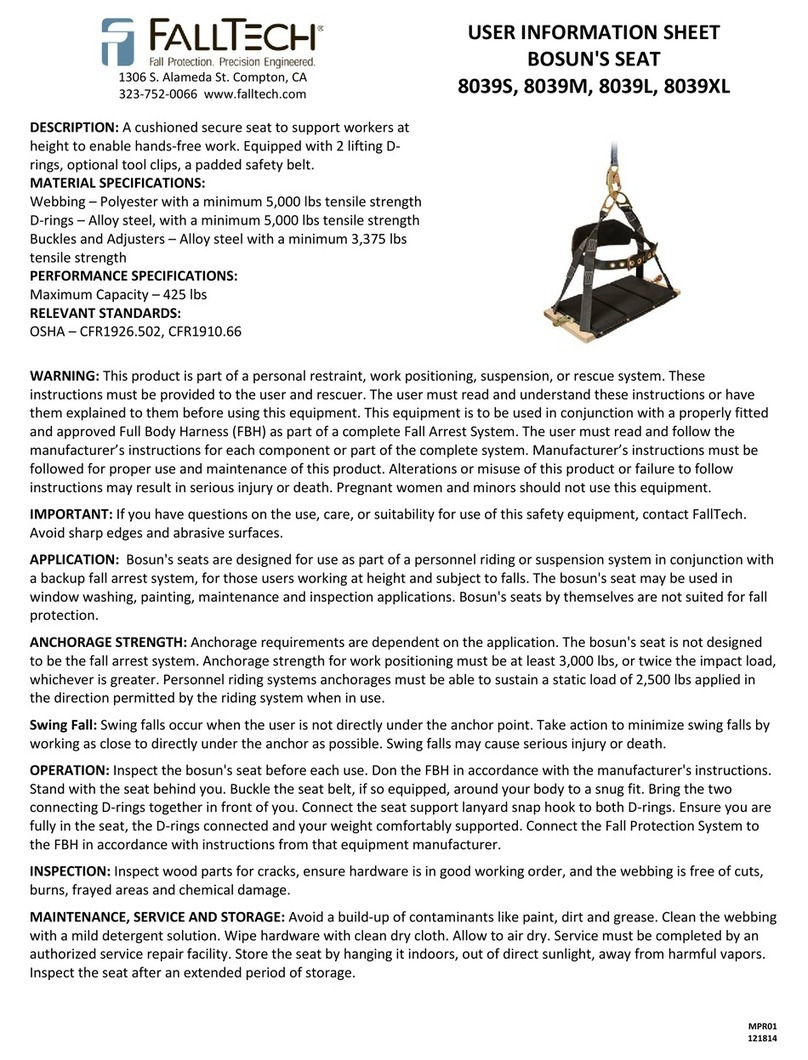
Falltech
Falltech 8039S User Information Sheet
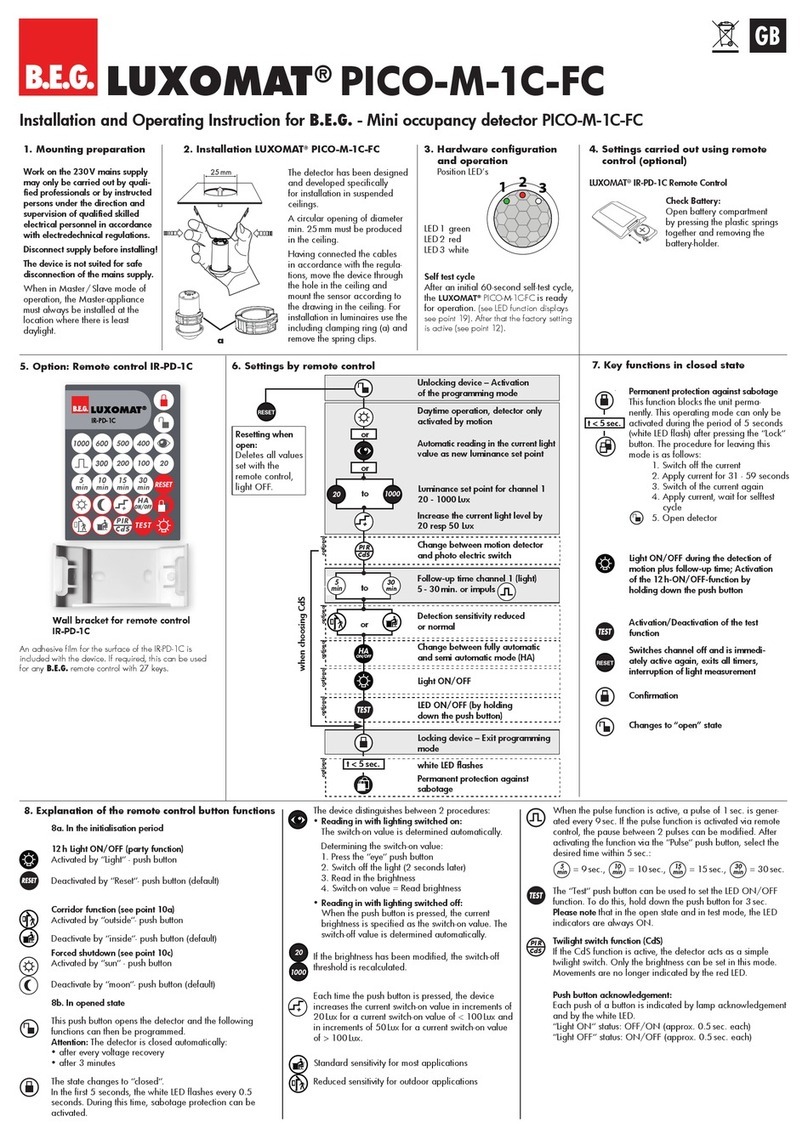
B.E.G.
B.E.G. Luxomat PICO-M-1C-FC Installation and operating instruction
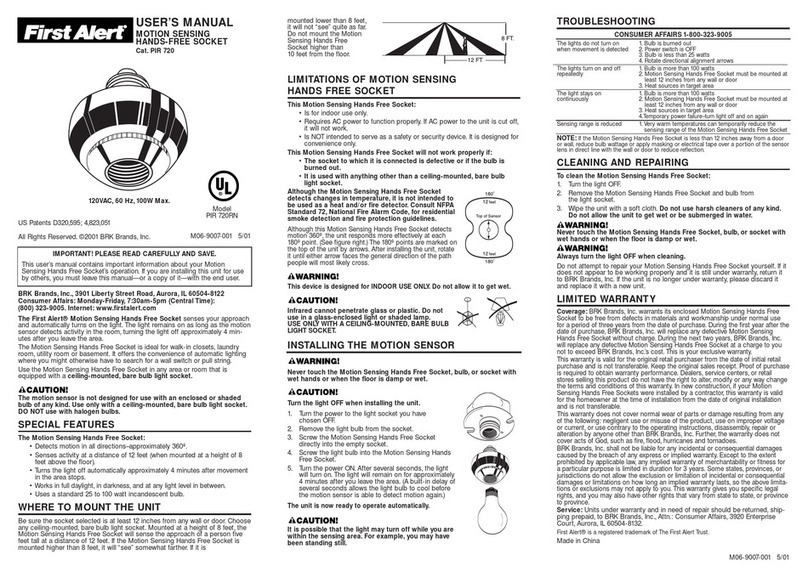
First Alert
First Alert PIR 720 user manual
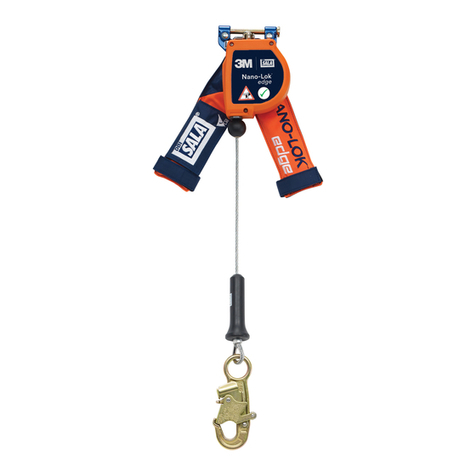
3M
3M Nano-Lok Edge Series instruction manual
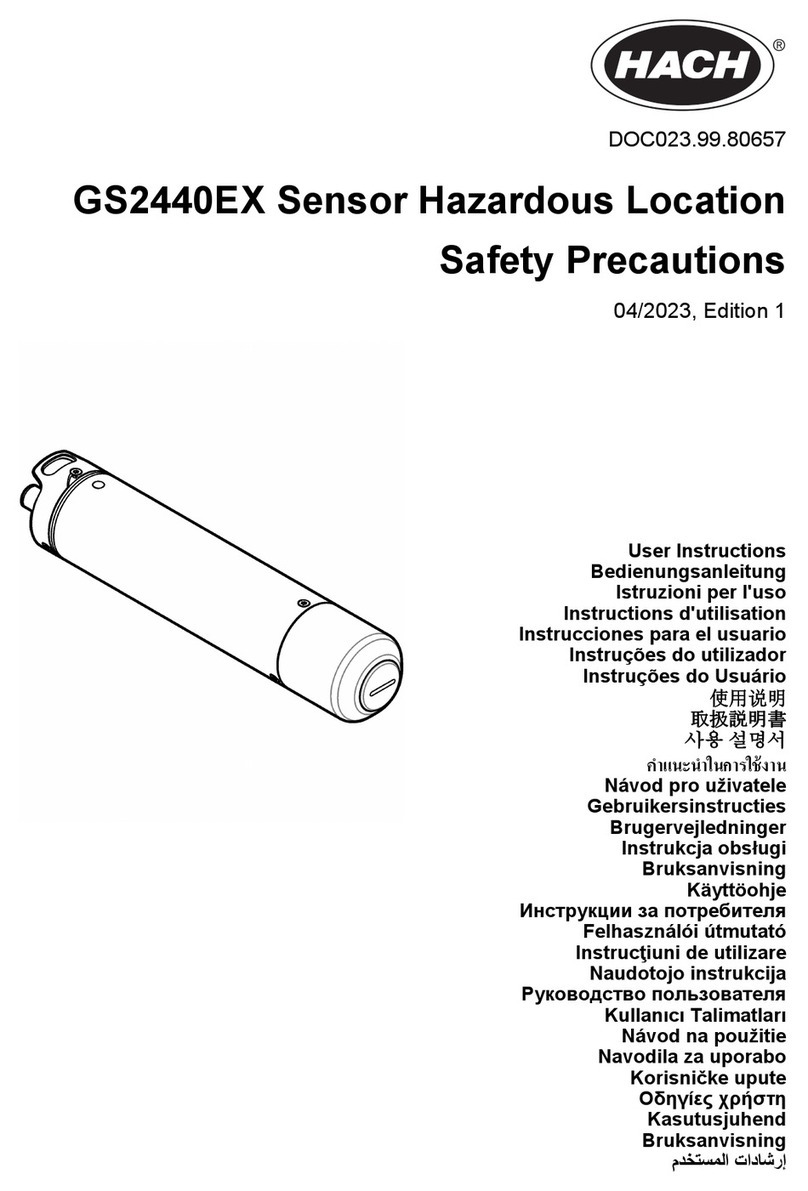
Hach
Hach GS2440EX User instructions
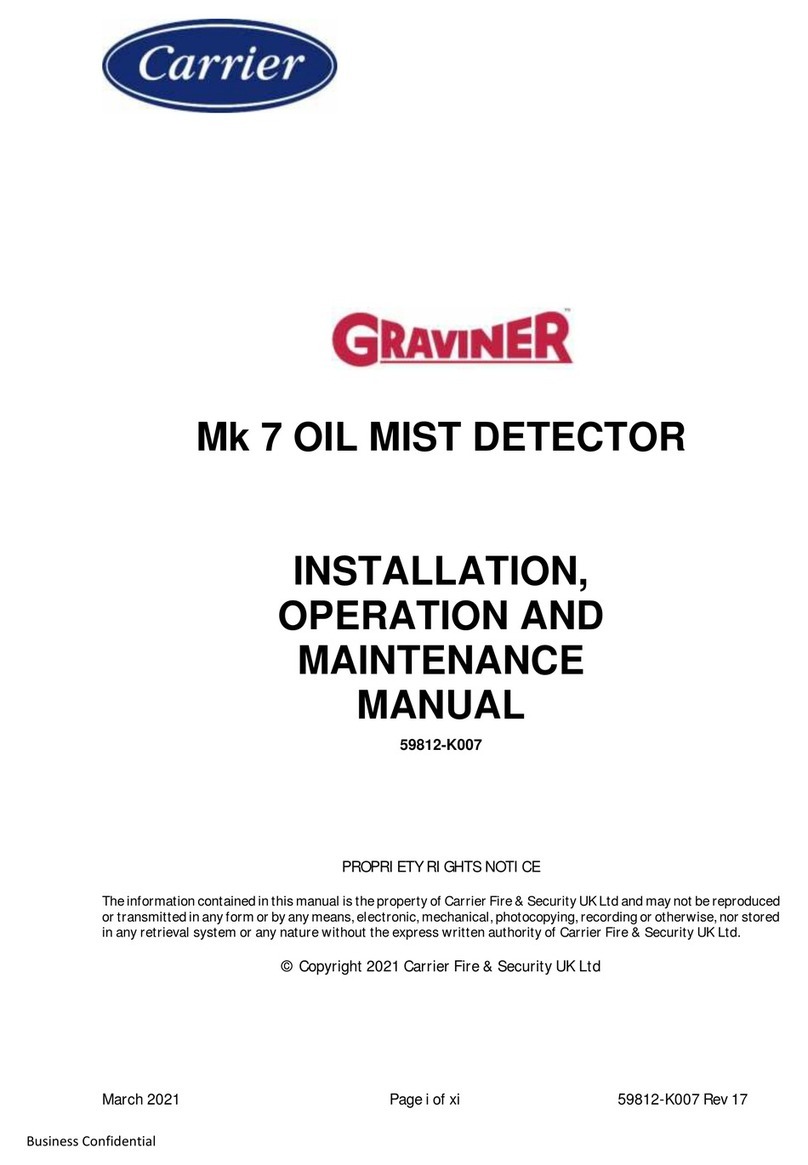
Carrier
Carrier Graviner Mk7 Installation, operation and maintenance manual
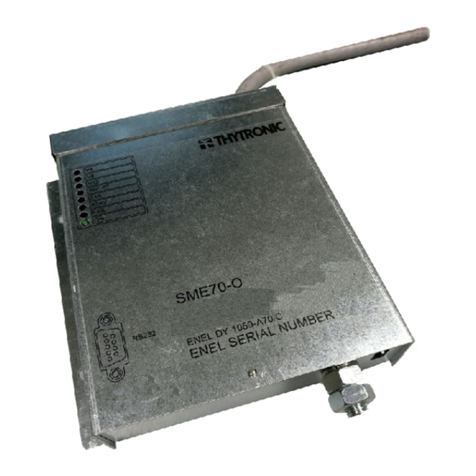
Thytronic
Thytronic SME70-O manual
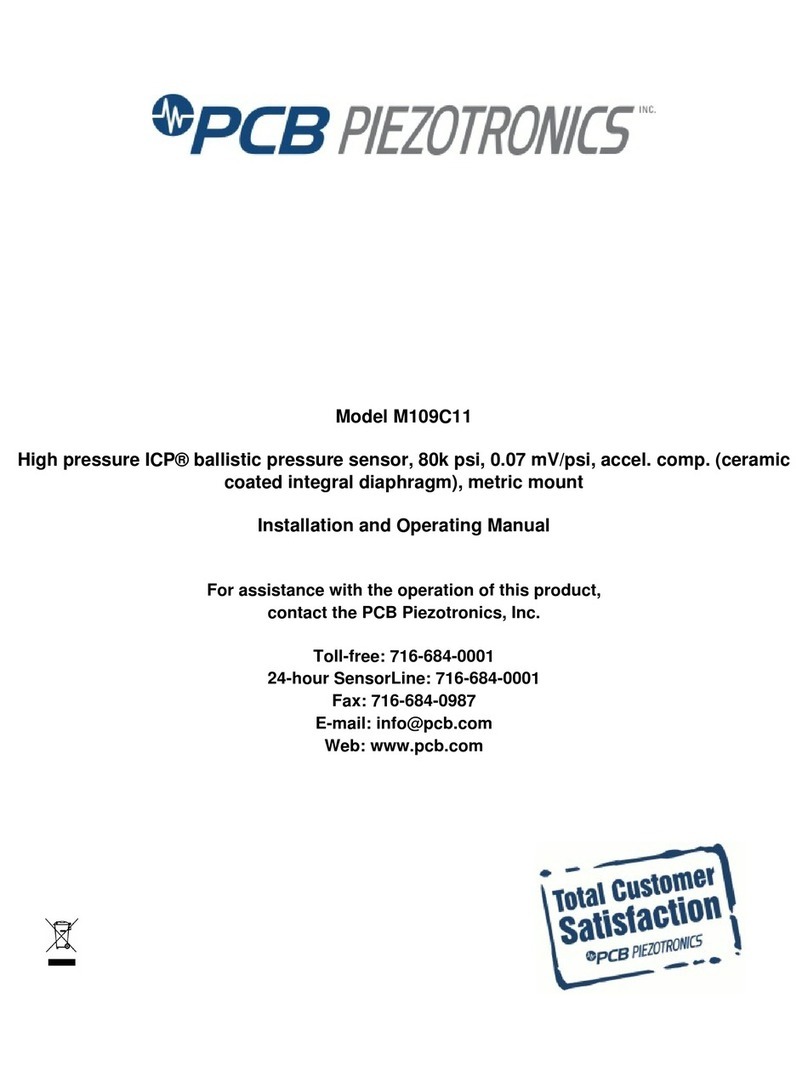
PCB Piezotronics
PCB Piezotronics M109C11 Installation and operating manual
Inficon
Inficon D-TEK Select operating manual
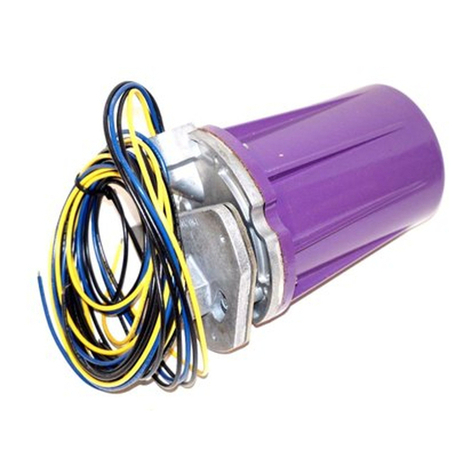
Honeywell
Honeywell Purple Peeper C7012A instructions
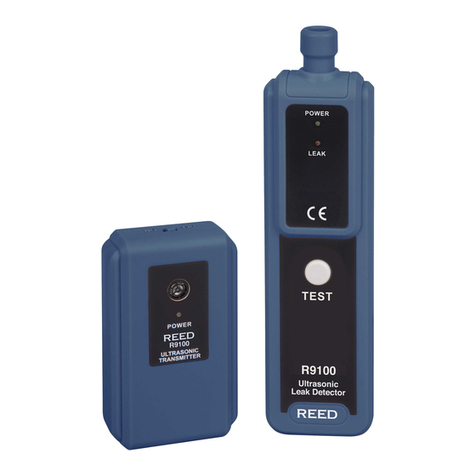
Reed Instruments
Reed Instruments R9100 instruction manual

